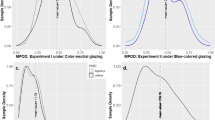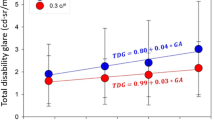Abstract
Objectives
The aim of the study was to analyze discomfort glare sensation in subjects aged 50 years and more in comparison with younger subjects (i.e. younger than 35 years of age).
Material and Methods
The experiments were performed on a computer workstation placed in controlled lighting environment where 2 discomfort glare conditions were modeled. Each participant performed for about 1 h specially designed visual tasks, including the tests with Landolt’s rings presented on the screen by a computer program. The glare evaluation method consisted of subjective evaluation of discomfort glare on the semantic glare rating scale, tests of mesopic contrast and glare sensitivity, subjective assessment of lighting quality and asthenopic symptoms. The time needed to perform the task and the number of mistakes were also recorded. The subjective evaluation of glare was compared with the Unified Glare Rating (UGR) index calculated by the DIALux simulation program.
Results
A higher percentage of the younger group subjects assessed glare after the experimental session as uncomfortable and intolerable than in the 50+ group, who more often assessed glare as acceptable. The assessment of discomfort glare in the younger group corresponded to higher UGR value compared to UGR value calculated by DIALux. In the 50+ group, such correlation was found only for lower discomfort glare (UGR = 19). The results showed that younger participants more frequently suffered from visual fatigue and assessed lighting as less comfortable. However, the mesopic glare sensitivity increased significantly after the experiments only in the 50+ group under both glare conditions.
Conclusions
The obtained results showed that discomfort glare sensation changes with age. The younger population seems to be more sensitive and demanding than the older one in relation to discomfort glare limiting, in spite of the lack of significant objective measures of fatigue. The exposure of the elderly to bigger discomfort glare could adversely affect the objective measures of fatigue like mesopic glare sensitivity and visual performance.
Similar content being viewed by others
References
Preamble to the Constitution of the World Health Organization as adopted by the International Health Conference, New York, 19–22 June, 1946; signed on 22 July 1946 by the representatives of 61 States (Official Records of the World Health Organization, no. 2, p. 100) and entered into force on 7 April 1948. Geneva, Switzerland [cited 2013 Oct 1]. Available from: http://www.who.int/about/definition/en/print.html.
Veitch JA. Lighting for well-being: A revolution in lighting? Proceedings of the 2nd CIE Expert Symposium on Lighting and Health (CIE x031:2006); 2006 Sep 7–8; Ontario, Canada. Vienna: Commission Internationale de L’Ecalirage; 2006. p. 56–61.
Commission Internationale de L’Ecalirage. Ocular lighting effects on human physiology and behavior. Vienna: CIE; 2004. CIE technical report no. 158.
Aschoff J. Handbook of behavioral neurobiology, biological rhythms. New York: Plenum Press; 1981.
Rea MS. Lighting handbook reference & application. 9th ed. New York: Illuminating Engineering Society of North America; 2000.
Veitch J, Newsham R. Determinants of lighting quality II: Research and recommendations. Ottawa: National Research Council of Canada; 1996. p 1–17.
Commission Internationale de L’Ecalirage. Discomfort glare in the interior working environment. Vienna: CIE; 1983. CIE Publication no. 55 (TC 3.4).
Wolska A. Glare as a specific factor in the working environment. Przegl Elektrotechn. 2013;89(1a/2013):142–144.
Hopkinson RG. Glare from daylighting in buildings. Appl Ergon. 1972;3:206–215, http://dx.doi.org/10.1016/0003-6870(72)90102-0.
Berman SM, Bullimore MA, Jacobs RJ, Bailey LL, Gandhi N. An objective-measure of discomfort glare. J Illuminat Eng. 1994;23:40–49, http://dx.doi.org/10.1080/00994480.1994.10748079.
Bennet CA. Discomfort glare, the effect of instructions. Special report #103. Manhattan: Kansas State University Engineering Experiment Station; 1972.
Clarke KC, Boyce PR, Beckstead JW. Factors influencing the stability of glare assessments. Proceedings of the Conference of the Illuminating Engineering Society of North America; 1991 Aug 11–15; Montreal, Canada. New York: Illuminating Engineering Society of North America; 1991. p.36–66.
Eble-Hankins M. Subjective impression of discomfort glare from sources of non-uniform luminance [dissertation and student research paper] [Internet]. University of Nebraska of Lincoln Architectural Engineering; 2008[cited 2013 Oct 1]. Available from: http://digitalcommons.unl.edu/cgi/viewcontent.cgi?article=1000&context=archengdiss.
Geedrinck L. Glare perception in terms of acceptance and comfort [graduation report]. Eindhoven: University of Technology; 2012.
Hopkinson RG. Evaluation of glare. Illum Eng. 1957;52(6):305–316.
Commission Internationale de L’Ecalirage. Lighting of work places part 1: Indoor. Vienna: CIE; 2001. CIE Publication S 008/E;2001.
European Committee for Standardization. Light and lighting. Part 1. Lighting of work places. Indoor work places. Brussels: European Committee for Standardization; 2011. European Standard EN 12464-1.
Wolska A, Sawicki S. Comparison of discomfort glare evaluation using different techniques. Proceedings of 12th European Lighting Conference LUX EUROPA 2013; 2013 Sep 17–19; Kraków, Poland. Warszawa: Polish Committee on Illumination (CIE Poland); 2013. p. 553–558.
Commission Internationale de L’Ecalirage. Discomfort glare in interior lighting. Vienna: CIE; 1995. CIE Publication no. 117 (TC 3–13) 1995.
Gross Figueiro M. Lighting the way: A key to independence. Lighting Research Center at Rensselaer Polytechnic Institute: New York; 2001 [cited 2013 Oct 1]. Available from: http://www.lrc.rpi.edu/programs/lightHealth/AARP/pdf/AARPbook1.pdf.
Nersveen J. Sight weakness and universal design. Proceedings of CIE 26th Session; 2007 Jul 4–11; Beijing, China. Vienna: Commission Internationale de L’Ecalirage (CIE); 2007. p. D 3–77.
Van de Kraatz J, van Norren D. Optical density of the aging human ocular media in the visible and the UV. J Opt Soc Am A. 2007;24(7):1842–1857, http://dx.doi.org/10.1364/JOSAA.24.001842.
Pinto MR, Medici S, Zlotnicki A, Bianchi A, Sant C, Napoli C. Reduced visual acuity in elderly people: The role of ergonomics and geronotechnology. Age Ageing. 1997;(26):339–344, http://dx.doi.org/10.1093/ageing/26.5.339.
Schierz C. Lighting for the elderly: Physiological basics and their consequences. Proceedings of the Conference LUX EUROPA 2009; 2009 Sep 9–11; Istanbul. Istanbul: Turkish National Committee on Illumination (ATMK); 2009. p. 147–154.
Geerdinck L, Zande B, Talen A, Erp T, Schlangen L. Comfortable lighting for seniors: The effect of illuminance and color temperature on the visual acuity in later life. Proceedings of the Conference LUX EUROPA 2009; 2009 Sep 9–11; Istanbul. Istanbul: Turkish National Committee on Illumination (ATMK); 2009. p.357–362.
Moosmann C, Wienold J, Wagner A, Wittwer V. Age effects on glare perception under daylight conditions. Proceedings of the Conference LUX EUROPA 2009; 2009 Sep 9–11; Istanbul. Istanbul: Turkish National Committee on Illumination (ATMK); 2009. p. 439–442.
DIALux [Internet]. DIAL light. Building. Software [cited 2013 May 15]. Available from: http://www.dial.de/DIAL/en/dialux.html.
Wolska A. Visual strain and lighting preferences of VDT users under different lighting systems. Int J Occup Saf Ergon. 2003;9(4):431–440.
Wolska A. Intelligent lighting systems and users’ visual fatigue. Przegl Elektrotechn. 2007;83(5):97–99.
Puell MC, Palomo C, Sanchez-Ramos C, Villena C. Mesopic contrast sensitivity in the presence or absence of glare in a large driver population. Graefes Arch Clin Exp Ophthalmol. 2004 [cited 2013 Oct 1];242(9):755–761. Available from: http://www.oculus.de/pl/sites/detail_ger.php?page=525.
Scharwey K, Krzizok T, Herfurth M. Night driving capacity of ophthalmologically healthy persons of various ages Ophthalmologe. 1998;95:555–558, http://dx.doi.org/10.1007/s003470050315.
Sawicki S, Wolska A. Algorithm of HDR image preparation for discomfort glare assessment. Przegl Elektrotechn. 2013;89(2a):87–90.
Author information
Authors and Affiliations
Corresponding author
About this article
Cite this article
Wolska, A., Sawicki, D. Evaluation of discomfort glare in the 50+ elderly: experimental study. IJOMEH 27, 444–459 (2014). https://doi.org/10.2478/s13382-014-0257-9
Received:
Accepted:
Published:
Issue Date:
DOI: https://doi.org/10.2478/s13382-014-0257-9




